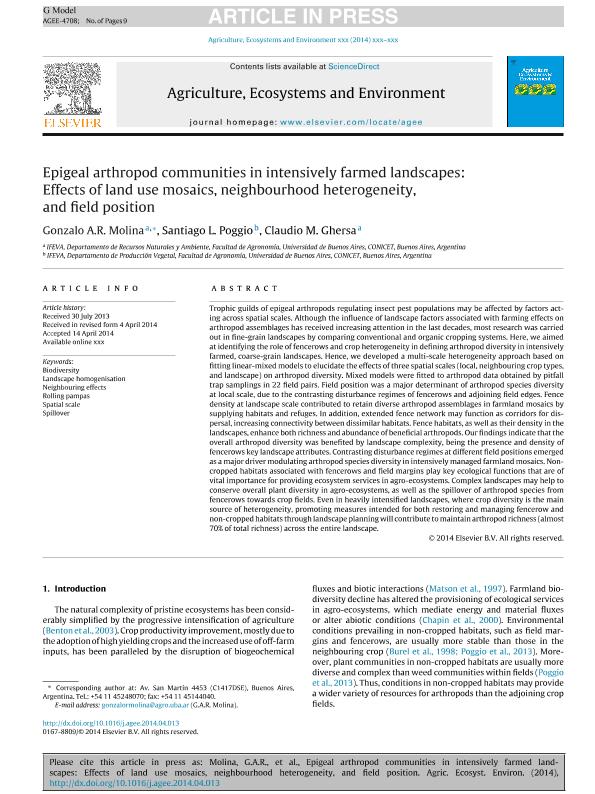Mostrar el registro sencillo del ítem
dc.contributor.author
Molina, Gonzalo Alberto Roman

dc.contributor.author
Poggio, Santiago Luis

dc.contributor.author
Ghersa, Claudio Marco

dc.date.available
2016-02-12T19:02:48Z
dc.date.issued
2014-05-10
dc.identifier.citation
Molina, Gonzalo Alberto Roman; Poggio, Santiago Luis; Ghersa, Claudio Marco; Epigeal arthropod communities in intensively farmed landscapes: effects of land use mosaics, neighbourhood heterogeneity, and field position; Elsevier; Agriculture, Ecosystems and Environment; 192; 10-5-2014; 135–143
dc.identifier.issn
0167-8809
dc.identifier.uri
http://hdl.handle.net/11336/4179
dc.description.abstract
Trophic guilds of epigeal arthropods regulating insect pest populations may be affected by factors act-ing across spatial scales. Although the influence of landscape factors associated with farming effects onarthropod assemblages has received increasing attention in the last decades, most research was carriedout in fine-grain landscapes by comparing conventional and organic cropping systems. Here, we aimedat identifying the role of fencerows and crop heterogeneity in defining arthropod diversity in intensivelyfarmed, coarse-grain landscapes. Hence, we developed a multi-scale heterogeneity approach based onfitting linear-mixed models to elucidate the effects of three spatial scales (local, neighbouring crop types,and landscape) on arthropod diversity. Mixed models were fitted to arthropod data obtained by pitfalltrap samplings in 22 field pairs. Field position was a major determinant of arthropod species diversityat local scale, due to the contrasting disturbance regimes of fencerows and adjoining field edges. Fencedensity at landscape scale contributed to retain diverse arthropod assemblages in farmland mosaics bysupplying habitats and refuges. In addition, extended fence network may function as corridors for dis-persal, increasing connectivity between dissimilar habitats. Fence habitats, as well as their density in thelandscapes, enhance both richness and abundance of beneficial arthropods. Our findings indicate that theoverall arthropod diversity was benefited by landscape complexity, being the presence and density offencerows key landscape attributes. Contrasting disturbance regimes at different field positions emergedas a major driver modulating arthropod species diversity in intensively managed farmland mosaics. Non-cropped habitats associated with fencerows and field margins play key ecological functions that are ofvital importance for providing ecosystem services in agro-ecosystems. Complex landscapes may help toconserve overall plant diversity in agro-ecosystems, as well as the spillover of arthropod species fromfencerows towards crop fields. Even in heavily intensified landscapes, where crop diversity is the mainsource of heterogeneity, promoting measures intended for both restoring and managing fencerow andnon-cropped habitats through landscape planning will contribute to maintain arthropod richness (almost 70% of total richness) across the entire landscape.
dc.format
application/pdf
dc.language.iso
eng
dc.publisher
Elsevier

dc.rights
info:eu-repo/semantics/openAccess
dc.rights.uri
https://creativecommons.org/licenses/by-nc-nd/2.5/ar/
dc.subject
Biodiversidad
dc.subject
Landscape Homogenisation
dc.subject
Neighbouring Effects
dc.subject
Rolling Pampas
dc.subject
Spillover
dc.subject.classification
Conservación de la Biodiversidad

dc.subject.classification
Ciencias Biológicas

dc.subject.classification
CIENCIAS NATURALES Y EXACTAS

dc.subject.classification
Ecología

dc.subject.classification
Ciencias Biológicas

dc.subject.classification
CIENCIAS NATURALES Y EXACTAS

dc.subject.classification
Agricultura

dc.subject.classification
Agricultura, Silvicultura y Pesca

dc.subject.classification
CIENCIAS AGRÍCOLAS

dc.title
Epigeal arthropod communities in intensively farmed landscapes: effects of land use mosaics, neighbourhood heterogeneity, and field position
dc.type
info:eu-repo/semantics/article
dc.type
info:ar-repo/semantics/artículo
dc.type
info:eu-repo/semantics/publishedVersion
dc.date.updated
2016-03-30 10:35:44.97925-03
dc.journal.volume
192
dc.journal.pagination
135–143
dc.journal.pais
Países Bajos

dc.journal.ciudad
Amsterdam
dc.description.fil
Fil: Molina, Gonzalo Alberto Roman. Consejo Nacional de Investigaciones Científicas y Técnicas. Oficina de Coordinación Administrativa Parque Centenario. Instituto de Investigaciones Fisiológicas y Ecológicas Vinculadas a la Agricultura; Argentina. Universidad de Buenos Aires. Facultad de Agronomia. Departamento de Recursos Naturales y Ambiente; Argentina
dc.description.fil
Fil: Poggio, Santiago Luis. Consejo Nacional de Investigaciones Científicas y Técnicas. Oficina de Coordinación Administrativa Parque Centenario. Instituto de Investigaciones Fisiológicas y Ecológicas Vinculadas a la Agricultura; Argentina. Universidad de Buenos Aires. Facultad de Agronomía. Departamento de Producción Vegetal; Argentina
dc.description.fil
Fil: Ghersa, Claudio Marco. Consejo Nacional de Investigaciones Científicas y Técnicas. Oficina de Coordinación Administrativa Parque Centenario. Instituto de Investigaciones Fisiológicas y Ecológicas Vinculadas a la Agricultura; Argentina. Universidad de Buenos Aires. Facultad de Agronomia. Departamento de Recursos Naturales y Ambiente; Argentina
dc.journal.title
Agriculture, Ecosystems and Environment

dc.relation.alternativeid
info:eu-repo/semantics/altIdentifier/url/http://www.sciencedirect.com/science/article/pii/S0167880914002102
dc.relation.alternativeid
info:eu-repo/semantics/altIdentifier/doi/http://dx.doi.org/10.1016/j.agee.2014.04.013
dc.relation.alternativeid
info:eu-repo/semantics/altIdentifier/issn/0167-8809
Archivos asociados
